fluent dpm(离散相模型)的壁面边界条件类型介绍
2016-10-07 by:CAE仿真在线 来源:互联网
fluent dpm(离散相模型)的避免边界条件类型用于描述离散相粒子与墙碰撞后发生的物理模型,在fluent中情况有好几种:
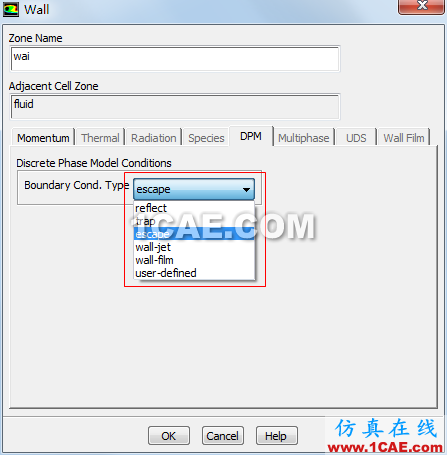
图:dpm避面类型
分别有:
1、reflect 反射——dpm颗粒到达后发生弹性碰撞,同时与避免发生热量交换,离散粒子继续运动,只是路线改变了
2、trap 捕获,离散粒子【不再】继续运动
3、escape 逃逸,消失了:如纱网壁面,如所有的inlet,outlet等
4、wall-jet 喷墙(反射和粘附并存,但不会形成膜)
5、wall-film 形成离散相物质的薄膜模型(墙膜),由于极薄的(最大50微米的)墙膜存在,离散相例子与这种墙撞击后其反射和散射,传热等情况均有特殊考虑,如汽油刚体内部
6、user-defined 自定义
对离散相通过particle tracks 的track功能,可以输出粒子的状态情况,其中包括了上述的一些状态在内,例如:
DPM Iteration ....
number tracked = 20, escaped = 1, aborted = 0, trapped = 19, evaporated = 0, incomplete = 0, incomplete_parallel = 0
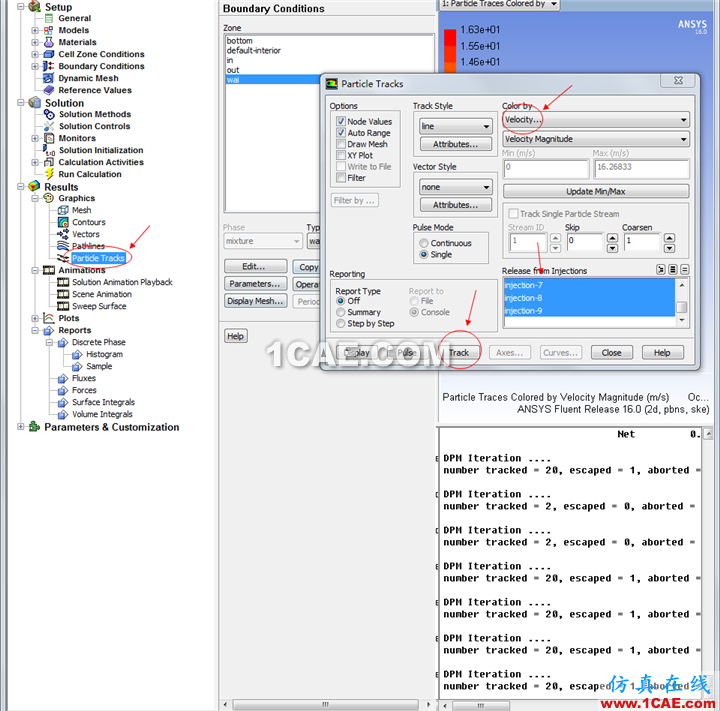
24.4. Setting Boundary Conditions for the Discrete Phase
When a particle reaches a physical boundary (for example, a wall or inlet boundary) in your model, ANSYS Fluent applies a discrete phase boundary condition to determine the fate of the trajectory at that boundary. One of several contingencies may arise:
The particle may be reflected via an elastic or inelastic collision.
The particle may escape through the boundary. The particle is lost from the calculation at the point where it impacts the boundary.
The particle may be trapped at the wall. Nonvolatile material is lost from the calculation at the point of impact with the boundary; volatile material present in the particle or droplet is released to the vapor phase at this point.
The particle may pass through an internal boundary zone, such as radiator or porous jump.
The particle may slide along the wall, depending on particle properties and impact angle.
The particle may form a film (wall film model).
You also have the option of implementing a user-defined function to model the particle behavior when hitting the boundary. More information about user-defined functions can be found in the Fluent Customization Manual.
The boundary condition, or trajectory轨道 fate归宿, can be defined separately for each zone in your ANSYS Fluent model.
For additional information, see the following sections:
24.4.1. Discrete Phase Boundary Condition Types
The available boundary conditions are
reflect
The particle rebounds off the boundary in question with a change in its momentum as defined by the coefficient of restitution. (See Figure 24.24: “Reflect” Boundary Condition for the Discrete Phase.)
Figure 24.24: “Reflect” Boundary Condition for the Discrete Phase
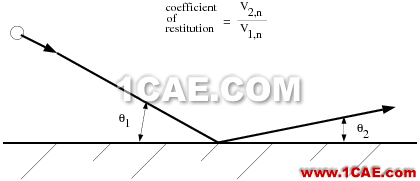
反射
The normal coefficient of restitution defines the amount of momentum in the direction normal to the wall that is retained by the particle after the collision with the boundary [109]:

(24–13)
where is the particle velocity normal to the wall and the subscripts 1 and 2 refer to before and after collision, respectively. Similarly, the tangential coefficient of restitution, , defines the amount of momentum in the direction tangential to the wall that is retained by the particle.
A normal or tangential coefficient of restitution equal to 1.0 implies that the particle retains all of its normal or tangential momentum after the rebound (an elastic collision). A normal or tangential coefficient of restitution equal to 0.0 implies that the particle retains none of its normal or tangential momentum after the rebound.
Nonconstant coefficients of restitution can be specified for wall zones with the reflect type boundary condition. The coefficients are set as a function of the impact angle, , in Figure 24.24: “Reflect” Boundary Condition for the Discrete Phase.
Note that the default setting for both coefficients of restitution is a constant value of 1.0 (all normal and tangential momentum retained).
trap
The trajectory calculations are terminated and the fate of the particle is recorded as “trapped”. In the case of evaporating droplets, their entire mass instantaneously passes into the vapor phase and enters the cell adjacent to the boundary. See Figure 24.25: “Trap” Boundary Condition for the Discrete Phase. In the case of combusting particles, the remaining volatile mass is passed into the vapor phase.
Figure 24.25: “Trap” Boundary Condition for the Discrete Phase
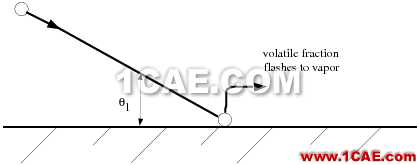
escape
The particle is reported as having “escaped” when it encounters the boundary in question. Trajectory calculations are terminated. See Figure 24.26: “Escape” Boundary Condition for the Discrete Phase.
Figure 24.26: “Escape” Boundary Condition for the Discrete Phase
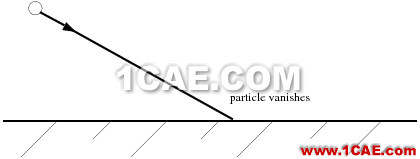
消失
wall-jet 喷射墙
这个模型类似于反射,但是有他特别的地方,即他根据粒子的运动特性,可能会产生反弹或不反弹而粘附在避免上。
适合于撞击后不会形成膜的情况,如非常热的墙,但不适合于形成的膜有显著作用的情况。
The wall-jet boundary condition provides a range of rebound directions and velocities when a liquid droplet collides with a wall. It is suitable for situations where droplets impact a hot wall, where no liquid film is formed, but the droplets reflect or stick on the wall depending on their impact properties. The direction and velocity of the droplet particles are given by the resulting momentum flux, which is a function of the impingement angle, , and Weber number.
A more detailed description of underlying theory is available in Wall-Jet Model Theory in the Theory Guide.
weber-number:韦伯数代表惯性力和表面张力效应之比,韦伯数愈小代表表面张力愈重要,譬如毛细管.高韦伯数表示惯性力占主流
wall-film 撞击后形成薄膜,墙膜
这个情况比较复杂,考虑了极薄的液态薄膜中的撞击,以及产生的传热、散射、蒸发、剪力、薄膜分离等多种情况
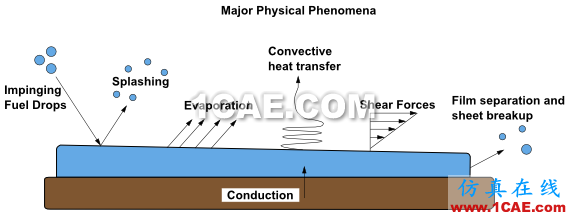
Figure 16.3: Mechanisms of Splashing, Momentum, Heat and Mass Transfer for the Wall-Film
For a list of limitations that exist with wall-film boundary conditions, see Limitations on Using the Lagrangian Wall Film Model.
interior
This boundary condition means that the particles will pass through the internal boundary. This option is available only for internal boundary zones, such as a radiator or a porous jump.
It is also possible to use a user-defined function to compute the behavior of the particles at a physical boundary. More information about user-defined functions can be found in the Fluent Customization Manual.
Because you can stipulate any of these conditions at flow boundaries, it is possible to incorporate mixed discrete phase boundary conditions in your ANSYS Fluent model.
Discrete phase boundary conditions can be set for boundaries in the dialog boxes opened from the Boundary Conditions task page. When one or more injections have been defined, inputs for the discrete phase will appear in the dialog boxes (for example, Figure 24.27: Discrete Phase Boundary Conditions in the Wall Dialog Box).
Figure 24.27: Discrete Phase Boundary Conditions in the Wall Dialog Box
Select reflect, trap, escape, wall-jet, wall-film, interior, or user-defined from the Boundary Cond. Type drop-down list under Discrete Phase Model Conditions, as shown in Figure 24.27: Discrete Phase Boundary Conditions in the Wall Dialog Box. (In the Walls dialog boxes, you will need to click the DPM tab to access the Discrete Phase Model Conditions.) If you select user-defined, you can select a user-defined function in the Boundary Cond. Function drop-down list. For internal boundary zones, such as a radiator or a porous jump, you can also choose an interior boundary condition. The interior condition means that the particles will pass through the internal boundary.
If you select the reflect type at a wall (only), you can define a constant, polynomial, piecewise-linear, or piecewise-polynomial function for the Normal and Tangent coefficients of restitution under Discrete Phase Reflection Coefficients. See Discrete Phase Boundary Condition Types for details about the boundary condition types and the coefficients of restitution. The dialog boxes for defining the polynomial, piecewise-linear, and piecewise-polynomial functions are the same as those used for defining temperature-dependent properties. The applied wall heat transfer model assumes that a liquid is getting in contact with the wall. See Defining Properties Using Temperature-Dependent Functions for details.
24.4.1.1. Default Discrete Phase Boundary Conditions
ANSYS Fluent makes the following assumptions regarding boundary conditions:
The reflect type is assumed at wall, symmetry, and axis boundaries, with both coefficients of restitution equal to 1.0
The escape type is assumed at all flow boundaries (pressure and velocity inlets, pressure outlets, and so on)
The interior type is assumed at all internal boundaries (radiator, porous jump, and so on)
The coefficient of restitution can be modified only for wall boundaries.
24.4.1.2. Particle-Wall Impingement Heat Transfer
To enable the particle-to-wall heat exchange for the reflect, wall-jet, or wall-film boundary conditions: In the Wall dialog box, under the DPM tab, enable the Particle-Wall Heat Exchange option. The option is available only for wall boundary conditions and unsteady particle tracking when the energy equation is enabled.
Figure 24.28: The Wall Dialog Box: the Particle-Wall Heat Exchange Option
Note that when a particle is reflected from a wall with the wall film DPM boundary condition, the particle-to-wall heat exchange is calculated directly between the particle and the wall. Any wall film present is not taken into account.
The model is applied for all inert, droplet, and multicomponent particles impinging on the wall. The specific model is not applied for the splashed particles. When the wall film DPM boundary condition is active, the model is applied in the Rebound Regime, and it is assumed that the particles hit the wall irrespective of the presence of a film. In the Splashing regime, the mass fraction that is deposited mixes with any existing film, and the splashed particles retain the impinging droplet temperature.
For combusting particles, the wall heat transfer is calculated only if the Wet Combustion Model option is enabled in the Set Injection Properties dialog box, and the particle liquid fraction is nonzero, otherwise the Particle-Wall Heat Exchange option has no effect.
相关标签搜索:fluent dpm(离散相模型)的壁面边界条件类型介绍 Fluent培训 Fluent流体培训 Fluent软件培训 fluent技术教程 fluent在线视频教程 fluent资料下载 fluent分析理论 fluent化学反应 fluent软件下载 UDF编程代做 Fluent、CFX流体分析 HFSS电磁分析






